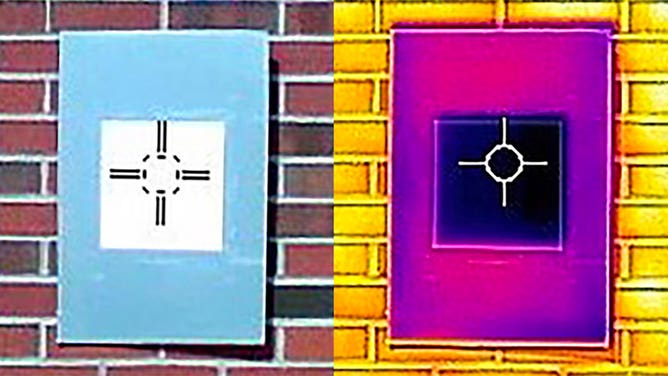‘Whitest white’ paint could make air conditioners less essential
Paint can reflect nearly all sunlight, engineer says

Xiulin Ruan, a Purdue University professor of mechanical engineering, holds up his lab’s sample of the whitest paint on record.
(Purdue University/Jared Pike)
WEST LAFAYETTE, Ind. – Air conditioners could soon be less essential thanks to a paint created by researchers at Purdue University.
The paint is being called "whitest white" for now, and it’s billed as the polar opposite of the Vantablack paint that was invented by a technology firm in the United Kingdom in 2014. That paint, which researchers described as "blacker than black," can absorb 99.9% of sunlight.
The ultra-white paint developed at Purdue can reflect 98.1% of sunlight. That’s compared to heat-rejecting paints on the market now that reflect 80% -90% of sunlight.
"When we started several years ago, we did not have the color in mind," said Xiulin Ruan, a mechanical engineer professor at Purdue. "We wanted to have this paint reflect as much sunlight as possible, so we can absorb little heat from the sunlight."
According to Ruan, the paint is so efficient at reflecting sunlight that it can cool itself below the temperature around it without any power. That could have some serious energy-saving applications.

An infrared camera shows how a sample of the "whitest white" paint (the dark purple square in the middle) actually cools the board below ambient temperature.
(Purdue University/Joseph Peoples)
"If you were to use this paint to cover a roof area of about 1,000 square feet, we estimate that you could get a cooling power of 10 kilowatts," Ruan said. "That’s more powerful than the central air conditioners used by most houses."
Researchers said the "whitest white" paint uses a high concentration of barium sulfate, a chemical compound used to make photo paper and cosmetics white, to get its color. The particles of barium sulfate are all different sizes, which helps the paint reflect a tremendous amount of light.
Ruan said researchers hope to have the paint on the market within a couple of years.
"So, right now, we’re optimizing the paint so it can be durable for many years," Ruan said.
The price is comparable or cheaper to titanium oxide paints that are used in commercial applications, according to Ruan.
To get the biggest bang for your buck, Ruan said, the paint must be facing the sky to get the best cooling effect.
According to researchers, tests showed that the paint can keep surfaces 19 degrees Fahrenheit cooler than their ambient surroundings at night and 8 degrees Fahrenheit below their surroundings under strong sunlight during noon hours.